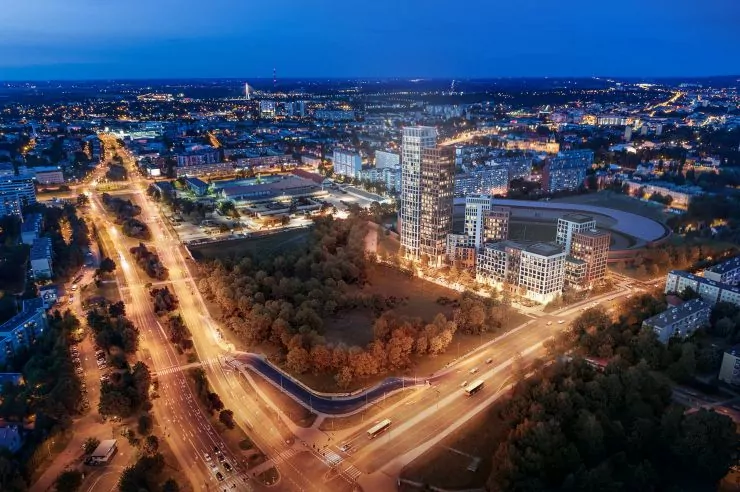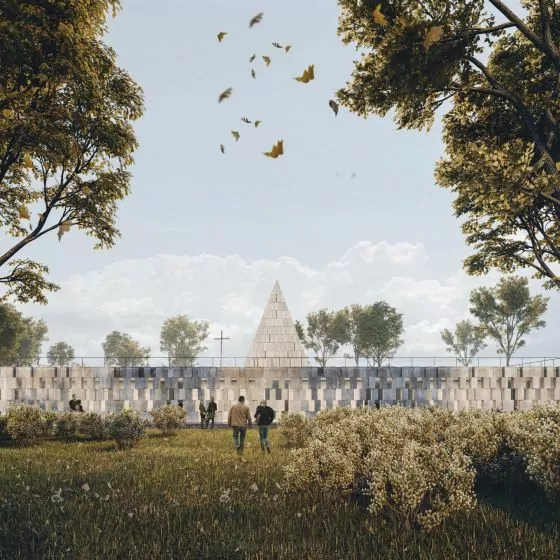On one of the plots of land on Wyspiańskiego Street in Rzeszów, in the vicinity of the city's stadium, designers from MWM Architekci studio have planned a new compact development quarter - Resovia Residence - a complex of residential buildings of varying heights with service and retail outlets on the first floors.



bird's eye view
© MWM Architects
The concept presented a few days ago has stirred up some controversy, firstly, the solution proposed by the studio is not in line with the current Municipal Land Use Plan, and the authors themselves are seeking to change it, explaining that the proposed investment will be more beneficial for this space. There were also doubts about locating residential facilities in such close proximity to the Resovia Stadium. We talk about the urban problems of the city, the shaping of the space and the very idea of the project with its author, Maciej Lobos of MWM Architekci studio.
left: site development plan; right: cross section
© MWM Architekci
Ola Kloc: Resovia Residence is meant to be an answer to the city's problems, such as uncontrolled suburban sprawl. Through what architectural, urban planning and functional solutions do you want to bring a new quality of space shaping to Rzeszow with this project?
Maciej Lobos: A key problem of all cities in the world, including Poland, due to lack of widespread awareness, is suburban sprawl, which results in increased infrastructure costs, environmental pollution, costs of time wasted in traffic jams, social problems, lack of opportunities for services and culture, educational and family problems. The key to solving this problem is something that, for our own use, we call "bringing people back to the city." We need to get people back to the inner city again. So that they can live there, work there, shop there, eat there, etc., without having to move around the city all the time. To do this, additions and densification of the existing urban fabric in the zones of the wider downtown are necessary. In Rzeszow, population density is several times lower than in Barcelona, and several times higher than in Copenhagen or Lisbon, for example. With such a dispersion of development, the city has no right to work.



view of the quarter
© MWM Architects
Ola: You are proposing to change the current Local Development Plan - among other things, lower development (in the draft it is 10-25 m, according to the old plan 18-25 m), a different height of the dominant building (100 m, which is 10 m more than in the old plan), the amount of green space (an increase of 10%) and development intensity (from 3-6 to 7.6). What are the chances of adapting the MPZP to your proposal? What does such a process look like?
Maciej: It's all up to the new Mayor and City Council. We, on the occasion of each project, try to explain from what assumptions architecture grows and what impact it has on the life of the community. You have to be aware that every action in the city violates some status quo, affects the interests of neighbors and the community as a whole. The city is a system of interconnected vessels, and therefore one cannot look at the interests of individuals, but check whether the synergy of our actions will benefit everyone in the long run. We can only convince - decisions are in the hands of politicians. It should also be remembered that the modern image of large metropolises, such as Paris or Barcelona, is the result, often drastic decisions of city authorities, who did not hesitate to massively demolish entire quarters of buildings, evict people and lay out completely new traffic arteries. Total democracy does not work in any area of life, and in spatial policy especially.



visualization
© MWM Architects
Ola: As you mentioned during the conference, you care about maintaining the right proportions between height and density of buildings, width of streets, surrounding greenery, public and private spaces. However, in the visualizations, what first catches the eye is the dominant 100-meter-high skyscraper. How are these proportions distributed in reality?
Maciej: We are dealing with a kind of gigantomania in Rzeszow, by the way, it seems that architects have such a general affliction that they design public spaces that are way too scaled, which results in the fact that this space gives the impression of being empty and, consequently, people do not want to stay there. What this looks like in our project is best shown by the cross-section. We checked these spatial relations for a very long time, analyzed what proportions the streets in historic cities have, and it seems to us that what we are proposing makes sense. Those who want wider streets, unfortunately, are unable to say what should happen in this wide space, how life should be organized there. It's also worth remembering that everything new provokes opposition from some people - the Eiffel Tower was terribly criticized by contemporaries and they wanted to dismantle it right after the World Exposition, but now no one can imagine the Paris skyline without its distinctive silhouette.
Ola: Thank you for the interview.





































